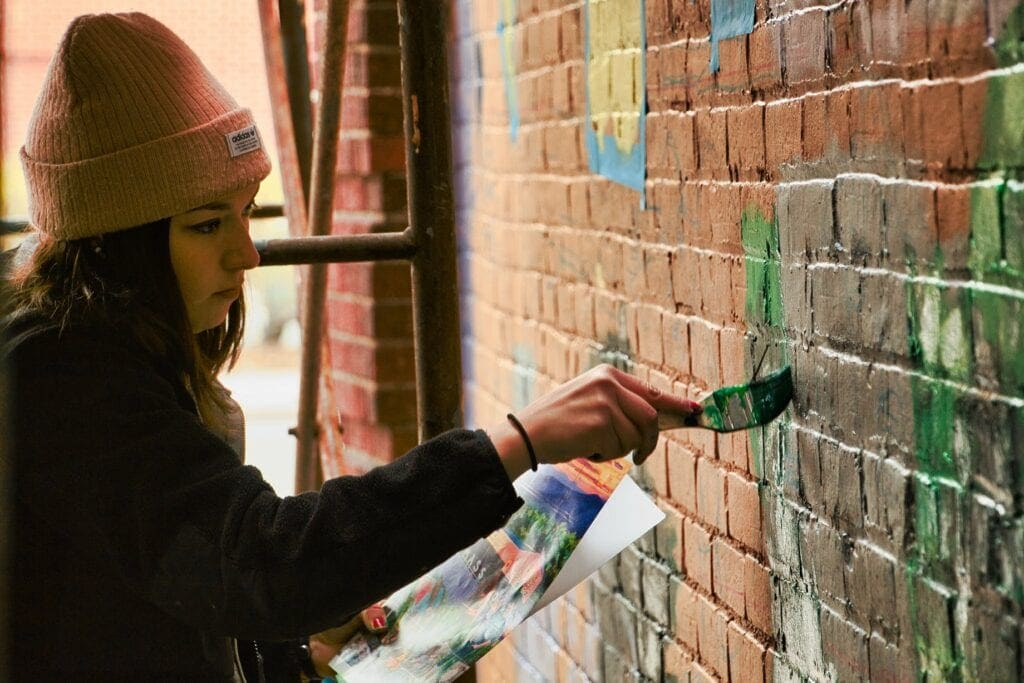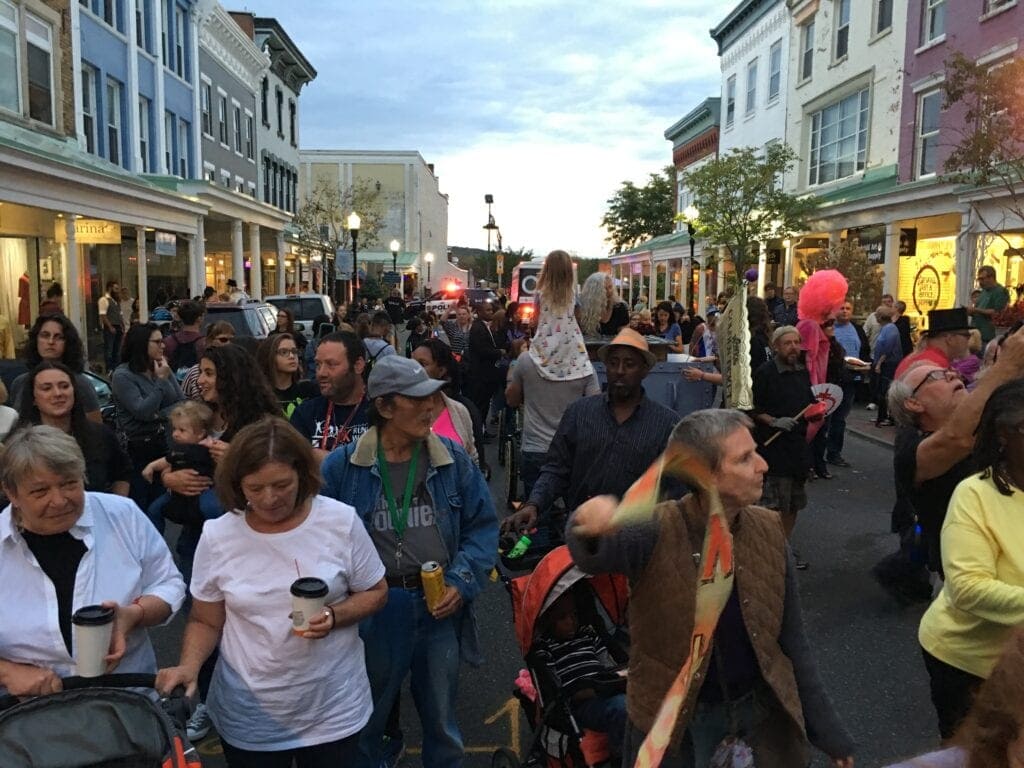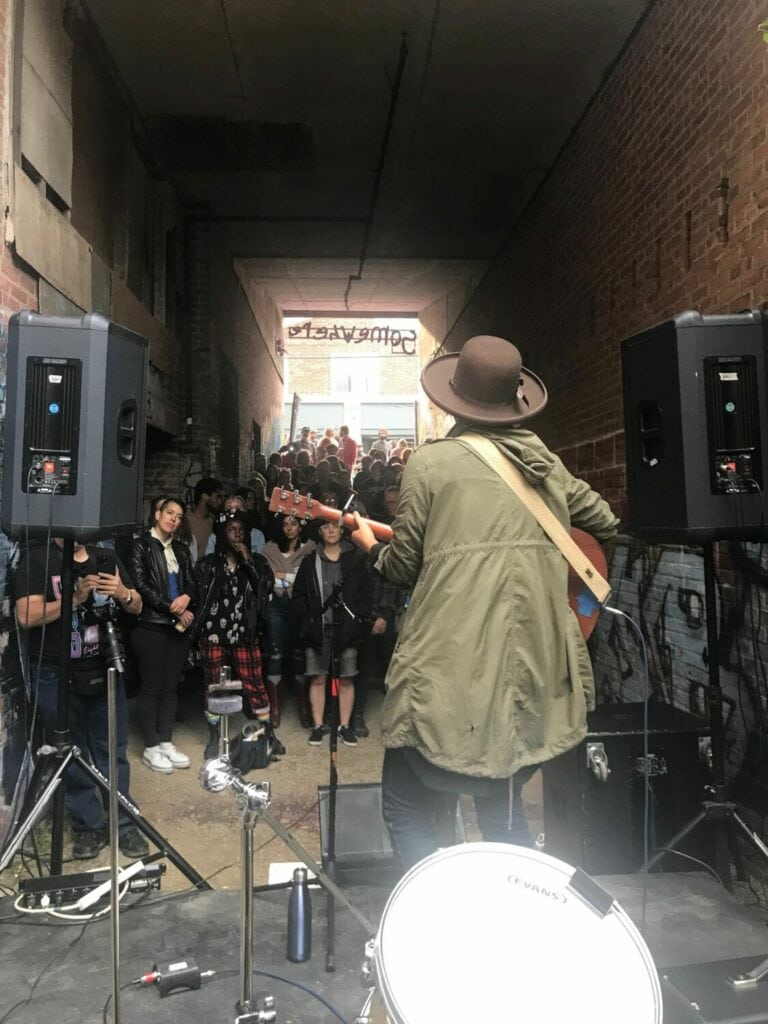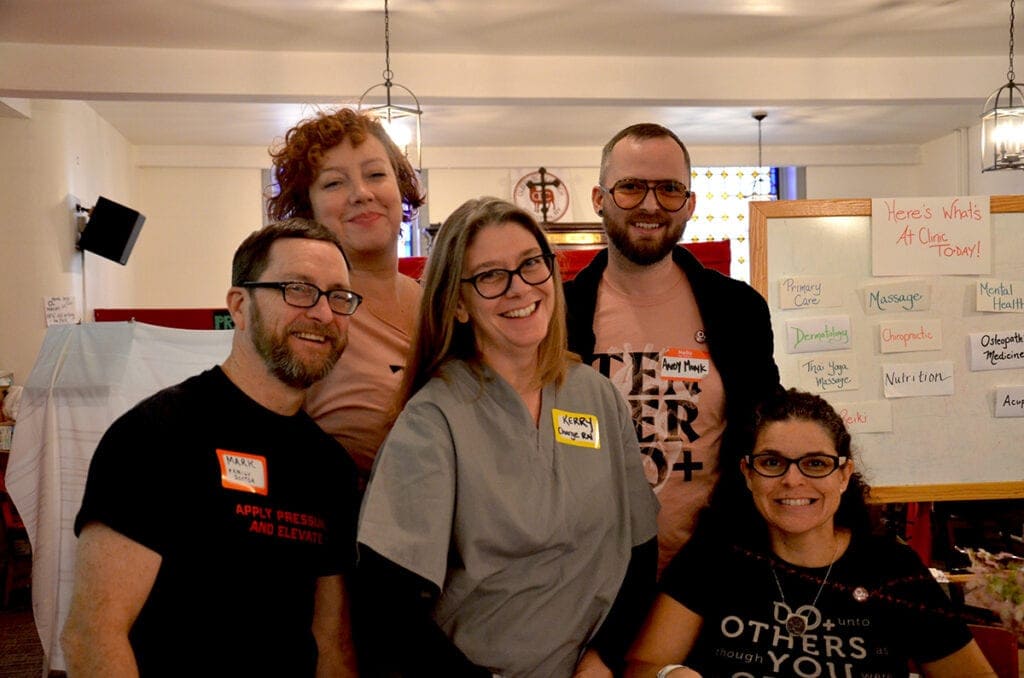Welcome to the ToO+lkit!
We exchange.
For us, the exchange is the art of medicine for the medicine of art. We’ve produced 18 festivals where artists and musicians received a range of wellness services like doctor and dentist visits, specialist visits, massage, alternative therapies, etc.. In return, the healthcare providers and the entire community are able to experience the benefits of the art and music.
Over the years we’ve had people ask us how they can do an exchange festival in their community. In response, we’ve developed two models. With our Launchpad model, the O+ National Team will work with you to put on a Festival. We’ll visit your city and do a landscape analysis to figure out whether an O+ will work there and what resources you’ll need to put it on. We work directly with your local team to put on an O+ Festival, complete with the O+ branding.
In the ToO+lkit model, we freely offer what we’ve learned over the past 12 years so you can build an exchange without O+ guiding every step of the process. We encourage you to take this and make your own exchange event without O+ branding. Maybe you’d like to exchange landscaping for mechanical work, or you’d like to do a festival of just music for dental services. However you decide to exchange, I hope this ToO+lkit will provide some helpful information. We’d love a shoutout when your event goes live!
If you’re interested in connecting with other folks around the world who are also using the ToO+lkit, we’ve put together a Slack that you’re welcome to join. Members of the O+ Team are also in this Slack to answer questions.
Happy Exchanging!
The O+ National Team
toolkit@opositivefestival.org
CO+nnect
You’re welcome to view the ToO+lkit below, download it as a pdf, connect with other people using the ToO+lkit via Slack, sign up for further ToO+lkit info, or communications from O+.
Let us know how you’d like cO+nnect!
Values and Mission Expression
Exchanging with others is a time-honored tradition. At O+ we developed a model of exchanging Art for Medicine. We deliver this exchange via festivals because everyone loves a party and because artists, musicians and other creative people in our communities continue to struggle with access to affordable healthcare. So we thought: What if we took money out of the system and instead valued each other equally? A dental filling equals a painting, a check-up with a primary care doctor equals a song! What started as a conversation between a Dentist and an Artist has grown into a nationwide project spreading healthcare and art and building more resilient communities.
We hope you will take our model of exchange and use it in your community. This guide is to help you get started. We are here to help. We are here to share knowledge. It’s all about the first small step…
Compassionate Radical Creative
Getting Started
Being able to explain yourselves concisely and quickly is invaluable. Who is your team? What idea or problem brought you all together? Who are you trying to serve and what do you hope to accomplish in that service? The ability to synthesize and tell your unique origin story will help you attract volunteers, community partners, donors and press.

Who you’re serving
The primary audience for an event like O+ are those who are directly participating in the exchange of the art of medicine for the medicine of art — the artists and musicians who will be creating/performing and the health and wellness providers who are getting them care.

Who is attending
The secondary audience are the event attendees, the largest percentage of whom should be part of the community in which your event takes place.
Maybe you’re an established organization that wants to add an exchange component or maybe you’re a person who likes the idea, but doesn’t have a structure in place to run it yet. If you’re new to this, consider the legal structure you’ll need to operate and potentially take in donations. Options include fiscal sponsorship, in which a 501c3 organization sponsors your organization and provides legal and fiscal structure for a small percentage of the donations received. If you’re with an established nonprofit organization already you’ll need to consider your budget requirements and how this exchange will fit into your work.
The costs to consider when you are in pre-planning mode depend on a few basic things: people power, programming, supplies, insurance, permits and marketing.
Here is an example of a one-day event budget, which is broken into categories:
Organization and clear communication are key when planning your event(s). Using a chat app, such as Slack, and an accountability and project planner, such as Asana, are great ways to keep your team on the same page and maintain transparency across tasks.
Planning
When choosing partner organizations and businesses, keep your mission and values in mind. Try to choose partner organizations and businesses with which you can grow. Have conversations that discuss how you envision your future together, and set goals you’d like to accomplish.
Similarly to seeking/choosing partners you can grow with, try to identify sponsors and donors you can see continuing to work with year after year. Make long-term fundraising goals and plans, and let that guide your asks.
Remember, no sponsor or donor is too small or too large, as long as they share your values.
Set up a meeting a couple of months in advance of your event with your city’s Director of Cultural Affairs or someone in a similar role. The purpose of the meeting is to loop them in, make sure you are filling in the right paperwork, and have the opportunity to ask each other for input. For example, you may want to request to close off a street or streets for a parade or an expo.
Some of the types of permits you can expect to fill out applications for include: general event permit, facility or park permits for bike rides or other activities, parade permit, and a noise permit. If you plan to have murals, then they may want to know where these are intended and whether they are in historic districts or on landmark buildings. Your local zoning board will most likely have information about that. You may be asked to present information about your event at a meeting or to a committee, so it is a good idea to start these permitting and application processes around two or three months before your event date to accommodate a variety of calendars.
You will also want to have event insurance that covers your organization and event participants in the case that something happens. During the conversations with the City and your venue or building owners, you may also be asked to provide them with a certificate of insurance (COI) that covers them to a certain amount, and names specific people. Many times, this information will be available on an event application, but it doesn’t hurt to ask.

The geographic layout of your festival directly determines who is able to participate/attend. Make sure you choose venues that, of course, share your values, but also operate as closely as possible to the population you are trying to serve.
Things to consider include:
- Easily available food options
- Public transportation
- Free or affordable parking
- Venue accessibility
Volunteers are the heart of the exchange. By definition, exchange relies upon volunteers to give to each other. Artists volunteer their time as do the doctors, dentists and wellness providers. Your event will also likely need volunteers to work backstage, help creatives navigate services, and collect donations. At the 2019 O+ Festival in Kingston, NY we had over 175 volunteers contributing to our three day event. Your volunteer needs will vary based upon your programming.
If your event is large in scope you may consider compensating people. We offer stipends to those who help coordinate the event, but we didn’t always. In the first years of our exchange it was all volunteer run and it was only in later years that fiscal compensation emerged as an option. As you think about your event and whether you want it to be sustainable in the future, this is a piece you should consider.
Look for a federally qualified health center in your area, and ask for a meeting with the medical director. Explain your mission and your values. Once you find someone who “gets it” it’s much easier to find more.
Look at other local health and hospital organizations for sponsorships and partnerships. Most doctors and wellness practitioners are as exhausted with the current healthcare system as the rest of us.
Look to the artists and musicians in your community for the majority of your participating talent. This allows for the building of long term relationships between local providers and creatives. If you identify that the best way to diversify your offerings is to recruit additional creative talent from outside the community, you need to budget for their travel and housing costs.
There are a few areas you will want to consider when it comes to safety and risk management. We have already discussed permitting and insurance, which handles liabilities with the public, the city, and venues. There are three other groups of people who are very important and have their own considerations: artists and/or musicians who are delivering programming; the event volunteers, and providers who are delivering services and consultations in the clinic; and your team of core organizers.
Participants
Participants should all receive some information about their site and any safety guidelines or questions in advance. For example, if they are muralist and you have secured a wall for them to work on, you will want to check in with them about the location, whether they have had training to operate a lift, and ensure they are willing to wear a harness according to OSHA requirements. If they are not local, they will need housing and if they are working at night, there needs to be a volunteer or team member who will help ensure safety. Participating artists should be encouraged to discuss their needs in advance so they can be supported to the fullest extent. In addition to receiving contracts which outline responsibilities between artists and the event organizers, all artists should know what their first steps will be when they arrive on site, and be aware of who their contacts are for the event.
Volunteers
Volunteers who are helping in general or in the clinic should receive an orientation so that they understand the event and the clinic specifically is a place of safety, acceptance, privacy and peace. We do not discriminate against any culture, race, religion, gender or sexual orientation, and all information shared in the clinic will be kept private.
Release forms
We ask that all participating artists, musicians, and volunteers fill in a liability release form, as well as a photo and video release form so that images taken during the public aspect of the event can be used for promotional purposes. Here is a liability release form template and a photo and video release form template. We also hang signs in venues that clearly state when events are being recorded or photographed, so that the public is aware that this is happening, and that they are consenting to this if they remain in the room.
Whether your core organizing team are staff members of your organization, you will want to be sure they are covered under your workers comp policy, and that everyone is following OSHA requirements. As your event date gets closer, you may begin to get a lot of questions, or have them yourself as you dive into details. There are times you might feel overwhelmed and start losing sight of the bigger picture. Establishing a line of communication to discuss challenges and how to meet them together from the beginning will help the team grow strong together. Know your personal signs of burnout and when you need to take a break or establish some boundaries. If possible, set up times for self-care so that this becomes part of your process.
A brand identity will help unify all the facets of your event and make it easily recognizable to the general public. Spend some time as a team brainstorming your brand. What makes your event and mission unusual? What story do you want to tell? Consider strong visuals (including a logo) and a tagline.
If you would like to use the O+ brand, contact us to discuss a Launchpad structure.
Follow-through Festival Weekend
It can sometimes be difficult to keep the mission front and center when providing the circus. Keep the crowd engaged, and look to the voices of your local community to see who you can help amplify.
Make sure that every single person who is given a microphone knows why everyone is there, and encourage them to tell a quick personal story related to your mission/any experience they’ve had with your organization already.
The key to the exchange is making sure all parties involved are equally valued, and equally benefitting.
Personal relationships will naturally develop between the practitioners and the creatives. Make sure the clinic and event schedules allow for those relationships to flourish.
The care is the “reason for the season” and should be at the forefront of your mind during the event.
During the event, the team stays connected in a number of ways. Some examples of technologies we use to communicate with each other include our own cell phones, walkie talkies, or push-to-talk apps like Zello. We also use Slack, a platform where you can instant message a number of people over different channels you create. Before the event, you can also make a call sheet that lists the contact information for all those involved in production. Run various scenarios by your team so that these are well thought out in advance. During orientation for volunteers, we typically discuss who to contact in the rare case of emergency, and who to reach out to when it comes to different situations. At our events, there is also a check-in location where anyone can go and receive information, including volunteers and team members.
Our volunteers come back year after year because they have an awesome experience. Part of this is preparing them in advance so they know what to expect from you and what you expect from them, they can represent you confidently, and they feel like they’re part of the team. Before you start, write up some guidelines for volunteers so they have a clear understanding of what the event is, what’s happening, how to operate any technological equipment, or any other info they’ll need to complete their tasks. Invite the volunteers to an orientation session where you can share this information and give them the opportunity to ask questions.
One key to repeat volunteers is appreciation. How do you care for your volunteers? Do they have access to the exchange? Do you throw a party for them afterwards? Do they receive a t-shirt or memento of their time? Small things can make a big difference for volunteers.
Designate at least one person to troubleshoot your chosen technology when (yes, when!) things go wrong.
Website schedule updates, merchandise terminals, etc. will all be in heavy use, so it’s best to have a few people who know how to perform basic fixes.
Whether you’ve decided to exchange art or music or gardening skills or cooking classes, you’ll need a supportive team who are in place to provide a backbone to the people participating in the exchange. In our model in which we exchange art and music for care, we have a committee of people and volunteers dedicated to supporting the artists and musicians. A clear welcome area and package for your participants, a team of people who can provide on-the-ground technical support, and people with subject area expertise are all on hand to make it a seamless event.
Healthcare Exchange
When artists and musicians are accepted into the festival we invite them to fill out a form letting us know what they think their healthcare needs are so we can be sure to source necessary specialists. We also give them the option to sign up for services that are offsite, like dental appointments.
On the weekend of our festival, when artists and musicians enter our Wellness Home, they’re first welcomed by a nurse who sits down with them and takes a clinical assessment. That nurse will help them navigate the services we have available, from primary care doctors to massage, specialist dermatologists to reiki practitioners.
Many volunteers support the Wellness Home, or Clinic, in order for it to be successful. A strong team of nurses and leadership is necessary.
Because we do not charge for these services, HIPAA is not applicable, however please keep in mind the need to respect confidentiality and privacy of those accessing services nonetheless.

Selfcare
At O+ we’ve chosen to have a strong community centered wellness focus in addition to healthcare for artists and musicians. We’ve offered a large array of programming available to the public, such as yoga, healthy cooking, gong baths, meditation and cycling events. Through these offerings we’re able to center wellness for everyone. Consider whether you want your exchange to be solely focused on the artists and musicians, or whether you want the direct wellness benefit to spread to the larger community too.
Engage local farms, supermarkets, restaurants and chefs when planning your greenroom.
This is an opportunity to make your potentially travel-weary creatives feel at home for at least a small time during your event.
If our experience has taught us anything, it’s that festival participants will remember the care and the greenroom more than anything else.
You should assign one person on your team to oversee all PR and Communications. Encourage collaboration. For example, all team members should take photos and small videos to share with the PR point person. Include as much information about each piece of content as possible as soon as possible (who, what, when, where and photographer’s name). The point person is in charge of sharing that content with the public and press. The PR and Communications team member should use social media platforms and digital newsletters to post event updates and FAQ for the public throughout the duration of the event.
If your event involves donations or financial transactions, there are different ways you can accept those: by cash, credit/debit payment through your customer relationship management (CRM) or PayPal, Square, checks, or through your ticketing platform (Eventbrite for example). You can also use a text-to-donate app like Give Lively.
Devise a plan for who will be overseeing payments and how. This includes where they will be set up at the event, how money will be held securely and reconciled, and then banked. In the weeks leading up to the event, if you are able to receive donations online in some way, whether they are for tickets, merch, or anything, it is good to encourage that in advance. This can help reduce the amount of cash transactions during the event.
In general, volunteer cash handlers should be supervised by a team member and cash is never left unattended. Cash is counted and reconciled in a secure environment and held in a secure place until it is possible to bank it, and that is ideally the same day or the next. Here is a reconciliation sheet that can be used as a template.
For security, two people should bank the cash, where practical. At the earliest possible date, reconciliation is made between cash banked and income summaries. Also, where practical, this is undertaken by a person other than those involved in the counting and cashing up of the money.
Partnering with a local bank can be really helpful in many respects. Volunteers who work at our bank have generously worked with us around various tasks such as collecting cash, counting it, recording it, and making deposits each day during our festival.
If you plan to have merchandise, it’s important to have someone available to oversee this before, during and after your event. This person will most likely be working closely with the volunteer coordinator to set up schedules for all locations that merchandise will be sold in advance, and take part in training volunteers.
In general, have someone standing behind your merch table at all times, have a system for taking money for goods in place (like Square, and a cash box with change), and have signage that helps present your products well. Having products with different price points (ie. under $10, under $25, under $50, etc.) and discounted bundles are good incentives for guests to buy your merchandise. T-shirts, bike jerseys and hats are popular. We order these in advance and offer them as an incentive to make an early donation. Our volunteers help roll t-shirts and write the size down on a piece of blue tape so that it stays organized and sizes are easy to find. It’s also nice to give some small things away for free, like buttons, posters, or decals.
Post-Festival Considerations
“After the glow, the stage, the scene, the set…” (Pavement)
Take a little time to decompress from the go-go-go of festival work and then throw a thank you party for all those involved. It will be great to have some numbers for the team to reflect upon. Think about what’s important to you to take away.
Overall
Number of participating artists and musicians, number of attendees, number of practitioners in clinic, number of dentists, number of wellness practitioners who offer classes, number of general volunteers

Health impact
Number of artists, musicians, or volunteers who visit the clinic; number of services received in the clinic; number of artists, musicians, or volunteers who visit a dentist, number of wellness classes offered to the public

Art and performance impact
Number of performances, number of bands or musicians performing, number of enduring murals or installations, number of temporary exhibitions and interactive projects
The impact of your event can be measured in direct and indirect ways, and will help you in your assessment and future planning. Questions to ask include: How did local organizations and businesses engage with your event? Did new relationships form, or did existing ones deepen? Did the event spark new connections? Has it broken through the access barrier to healthcare or wellbeing for the participating artists or musicians? How? Interviewing participants and taking pictures or video during and after the event will help with this.
With all the data you’ve gathered you are ready to analyze how it went and decide how to move forward. Ask yourself:
- Are you happy with a one off event or would you like to do it again?
- What would you do differently?
- What would you keep the same?
You can consider whether you have the resources and support to continue the event. What would you need to make it sustainable? We’ve found that a stumbling block to Year 2 can be financial resources and team capacity. If you’d like to keep it going, make a plan now to address these or other identified issues.
Event alumni are your most valuable assets. They can share your mission and work with a larger audience, and, sometimes, fundraising as well! Keep up communication with them.
At the end of the event, send a thank you to them with a small survey asking about their experience.
They’re the ones who have gone through your pipeline. Their input is invaluable.
Send them a regular newsletter letting them know what you’re up to. Keep track of them on their social media channels and help promote their work when possible.
Upload your photos and videos to a shared drive or online archive. Include as much caption information as possible as soon as possible: name of artist, venue, date the photo was taken, a one-sentence description, and the name of the photographer/videographer. You might want to organize the content into categories i.e. art, music, wellness, parade, health expo, etc.
Thank you to the Center for Cultural Innovation for generously supporting this project.
